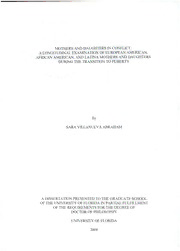
Mothers and daughters in conflict : a longitudinal examination of European American, African American, and Latina mothers and daughters during the transition to puberty PDF
Preview Mothers and daughters in conflict : a longitudinal examination of European American, African American, and Latina mothers and daughters during the transition to puberty
MOTHERSANDDAUGHTERSINCONFLICT: ALONGITUDINALEXAMINATIONOFEUROPEANAMERICAN, AFRICANAMERICAN,ANDLATINAMOTHERSANDDAUGHTERS DURINGTHETRANSITIONTOPUBERTY By SARAVILLANUEVAABRAHAM ADISSERTATIONPRESENTEDTOTHEGRADUATESCHOOL OFTHEUNIVERSITYOFFLORIDAINPARTIALFULFILLMENT OFTHEREQUIREMENTSFORTHEDEGREEOF DOCTOROFPHILOSOPHY UNIVERSITYOFFLORIDA 2004 ACKNOWLEDGMENTS Thereareseveralpeoplewhohaveplayedsupportiverolesformeduringmy yearsasagraduatestudent.Iwouldliketotakethisopportunitytothankthesepeoplefor theirguidanceandencouragementthroughtimesthatwerenoteasyforme.First,special thanksgotothefamilieswhoparticipatedinthisstudy.Thesegirlsandtheirfamilies tooktimeoutoftheirbusyschedulesandkindlyalloweddatacollectorsintotheirhomes; forthis,Iamextremelygrateful.Second,1wouldliketoacknowledgethatthisstudywas supportedbygrantsfromtheNationalInstituteofChildHealthandHumanDevelopment (NICHD;HD32376)andtheNationalInstituteofMentalHealth(NIMH;MH56557). Further,theassistanceofthestaffoftheGirls’HealthandDevelopmentProjectat TeachersCollege,ColumbiaUniversity,andtheObservationalCodingLaboratoryatthe UniversityofFloridaisgreatlyappreciated. Specialthanksgotomycommitteemembers:Dr.ScottMiller,Dr.Mark Fondacaro,Dr.LiseYoungblade,andDr.ConnieShehan.Withtheirassistanceand continualguidance,1havelearnedthefinerpointsofacademicwritingand methodologicallybasedresearch. Specifically,1wouldliketosincerelythankmy advisor.Dr.JuliaGraber,forherunendingsupportandencouragementaswellasher persistentguidanceandteaching.Herstellarperformanceasanacademicscholarhas beenandwillcontinuetobeaninspirationtome. 1amextremelythankfultomyfamily.Thesupportandencouragementthatmy parents,mybrothers,andmysistershavegivenmehavebeeninvaluable.Itrulythank ii myparentsforteachingmethatwithhardwork,determination,andfaithanythingis possible.Itismyfamily’sunconditionalandunwaveringsupport,love,and encouragementthathavesustainedmeandhelpedmetosucceed. Finally,merewordscannotexpresstheheartfeltgratitudethatIoffertomy children:Susan,Thomas,andSophia.Therehavebeenmanysacrificesmadeduringmy timeingraduateschool,andIknowthatmylimitedtimeandenergyhavemadethings difficultattimes.Still,theirtighthugsandsoftkissesgavemethestrengththatIneeded toendure.1wouldlikeforthemtoknowthateverything1do,1doforthem.Itruly appreciatetheirpatienceandunderstanding. Ill TABLEOFCONTENTS page ACKNOWLEDGMENTS ii ABSTRACT vi 1 INTRODUCTION I 2 LITERATUREREVIEW 6 DevelopmentalChangesinParent-ChildRelationshipsandConflict 6 MiddleChildhood 7 NormativeChangesinParent-ChildRelationships 8 TheMother-AdolescentRelationship 10 TheoreticalModelsofParent-childConflictDuringAdolescence 10 ConflictinContext 18 PotentialCulturalDifferencesinConflict 24 Conclusions 37 SignificanceofthePresentStudy 37 GeneralLongitudinalExaminations 38 PredictingConflict 39 LinksBetweenConflictandAdjustment 40 DyadicInteraction 41 3 METHOD 42 Participants 42 Procedure 43 Measures 47 AnalysisPlan 55 4 RESULTS 57 DescriptiveAnalyses 57 GeneralLongitudinalExaminations 63 PredictingConflict 69 DyadicInteraction 78 IV 5 DISCUSSIONANDCONCLUSION 80 Conflict 82 Respect 84 MaternalBehaviors 87 Puberty 90 LinksBetweenConflictandAdjustment 92 DyadicInteraction 94 Limitations 95 Conclusions 96 REFERENCES 98 BIOGRAPHICALSKETCH 110 V AbstractofDissertationPresentedtotheGraduateSchool oftheUniversityofFloridainPartialFulfillmentofthe RequirementsfortheDegreeofDoctorofPhilosophy MOTHERSANDDAUGHTERSINCONFLICT: ALONGITUDINALEXAMINATIONOFEUROPEANAMERICAN, AFRICANAMERICAN,ANDLATINAMOTHERSANDDAUGHTERS DURINGTHETRANSITIONTOPUBERTY By SaraVillanuevaAbraham August2004 Chair:JuliaA.Graber MajorDepartment:Psychology Thisstudyexamineshowmother-daughterrelationshipsandconflictspecifically developovera3-yearperiod.ThesampleincludedAfricanAmerican,European American,andLatinagirlsandmothers.Mothersanddaughtersreportedonconflict frequencyandintensity,andchildren’sinternalizingandexternalizingbehaviors. Mothersreportedonparentingbehaviorsandbeliefs.Videotapedinteractionswerecoded toassessrespect,communication,andrelationshipquality.Conflictdidnotincreaseover time,nordiditvarybyethnicityacrosstime.Respectwasdifferentiallysalienttodyads ofdifferingethnicities,withmother-reportedconflictintensityandrespectmoderatedby ethnicityatbothtimepoints.AlthoughAfricanAmericanandLatinamothersreported significantlyhigherlevelsofdisciplinarybehaviorsatbothassessments,mothersand daughtersfromallethnicitiesreportedpositive,nurturantrelationships.Neitherpubertal statusnortimingdirectlypredictedconflict,buttimingandconflictweremoderatedby VI ethnicity.Finally,conflictduringlate-childhoodwasassociatedwithadolescent adjustmentduringearlyadolescence. CHAPTER 1 INTRODUCTION Tremendouseffortshavebeenputforthtoinvestigateboththequalityand transformationsofparent-childrelationshipsduringadolescence.Researchinthisfield hasshownrepeatedlythattheperiodofearlyadolescenceisoftenatimeofincreased emotionalandphysicaldistancingfromparents(Csikszentmihalyi&Larson,1984; Holmbeck,1996;Paikoff&Brooks-Gunn,1991;Steinberg,1989),aswellasatimein whichdisagreements,minorconflicts,andemotionaltensionsaremorefrequently experiencedbyparentsandtheiradolescentchildren(forreviews,seeHolmbeck,1996; Laursen&Collins,1994;Laursen,Coy,&Collins,1998;Steinberg,1990;Steinberg& Silk,2002).Examinationsofconflictwithparentsbefore,during,andafteradolescence indicatethatconflictandagearerelatedinaninvertedU-shapedfunction,suchthat conflictincreasesduringearlyadolescence,isreasonablystableduringmiddle adolescence,anddeclineswhentheadolescentmovesawayfromhome(Montemayor, 1983).Conflictsduringearlyadolescencehavebeenreportedtooccurfairlyfrequently, withadolescentsreportinganaverageofsevendisagreementsperday(Laursen.1989) butarenottypicallyintense,volatile,orindicativeofmajorproblems.Infact,despite fairlyfrequentconflictatthisageperiod,onlyaverysmallminority(5%-10%)ofall familieswithadolescentsexperienceseriousproblemsoramarkeddeteriorationin parent-childrelationships(Steinberg,1990).Moreover,researchhasconsistently indicatedthatconflictsbetweenparentsandadolescentsrarelyoccurovercriticaltopics 1 2 suchasreligion,politics,sex,ordrugs;rather,theseconflictsoccurovereverydayfamily issuessuehasschoolwork,chores,andgettingalongwithsiblings(Collins&Russell, 1991;Smetana,1988).Insum,althoughrepetitivebickeringbetweenparentsand adolescentsbecomesanissuethatissomewhatdisruptiveintheirdailylives,research suggeststhattheresultisusuallyastrong,healthyparent-childrelationshipthatcontinues todevelopastheymovebeyondtheperiodofadolescence. Althoughpopularnotionsandstereotypesoftheparent-adolescentrelationshipas oneinwhichthereisextremehostility,anger,andintenseconfliethavenotbeen confirmedinempiricalexaminationsofteenagersandtheirparents,adolesceneehasbeen shownbyresearcherstobeatimeforrealignmentsandredefinitionswithinthefamily.It hasbeensuggestedthatmoderateamountsofconflictoccurringwithinthecontextofa warm,caringenvironmentcanbesomewhatfunctionalintransformingtheunilateral parent-childrelationshipsofmiddlechildhoodtothemoremutualrelationsoflate adolescenceandyoungadulthood(Holmbeck,1996;Steinberg,1990;Youniss& Smollar,1985).Nonetheless,the“stormandstress”stereotypescontinuetopersistinthe popularmainstreammedia.OneexplanationforsuchpersistenceproposedbySteinberg (2001)isthatparentsaremorenegativelyaffectedbythefrequentbickeringand squabblingthattakesplaceduringthistimethanareadolescents,andparentsaremore likelytoholdontothenegativeaffectafteran interactionwiththeirteenager. Furthermore,Steinbergsuggeststhattheday-to-dayconflictsovermundaneissuesthat researchershavepreviouslydismissedasunimportantwere,infact,unimportantto teenagersbutwereasignificantsourceofdistressforparents(Silverberg&Steinberg, 1990;Steinberg,2001).Thus,althoughthesemildlyupsettinginteractionsovereveryday 3 mattersdonotdisruptthelong-termparent-childbond,theydoseemtotakeatollon parentalmentalhealth,especiallyamongmothers(Silverberg8cSteinberg,1987). Althoughsomeresearchhasfoundthatadolescentsarenotnegativelyaffectedby conflictwiththeirparents,thereisalimitedbodyofresearchthathasestablishedalink betweenparent-adolescentconflictandadolescentadjustment.Hauserandhiscolleagues (Leaper,Hauser,Kremen,8cPowers,1989)haveshownthatwithinthecontextof adolescent-parentinteractions,familycommunicationpatternssuggestingeither closenessorseparationdirectlyinfluenceadolescents’egodevelopment.Moreover, Hauserhasalsoshownthatvaluesemphasizedwithinfamilyenvironments(thatis, familyorientationstowardindependence,participationinactivities,expressiveness,and achievement)areassociatedwithadolescents’perceivedcompetenceandself- perceptions(Hauser,Jacobson,Wertlieb,&Brink,1985).Additionalstudiesfound significantassociations(a)betweenparentalinteractionsandadolescentself-esteemand (b)betweenadolescents’difficultyestablishingautonomyandrelatednessinthecontext offamilyinteractionsandinternalizingandexternalizingbehaviors(Allen,Hauser, Eickholt,&Bell,1994;Isberg,Hauser,Jacobson,&Powers,1989).Mostcentrally, Rueter,Scaramella,Wallace,andConger(1999)examinedtheimpactofparent-child conflictoninternalizingsymptomsanddisorder.Findingsfromthisstudysuggestthatboth internalizingsymptomsandparent-childconflictinearlyadolescence(ages12-13) predictedchangesininternalizingsymptomsovertimeandinreportsofhistoryofdisorder byyoungadulthood(ages19-20). Specifically,priorparent-childdisagreementinfluenced internalizingdisordersviatheirindirecteffectonsubclinicalsymptomsratherthanviaa directpathtoalaterdisorder(Graber,2004).Insum,althoughparent-adolescentconflictis seenassomewhatnormativeandbenign,empiricalresearchindicatesthatindeedthereare
